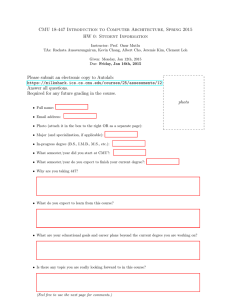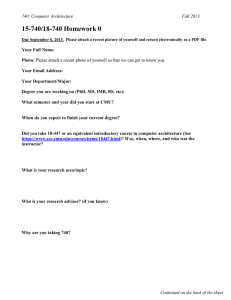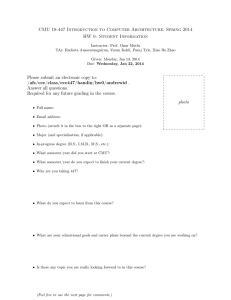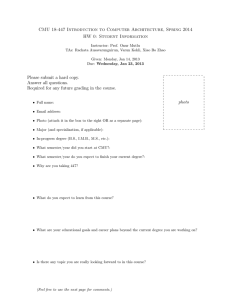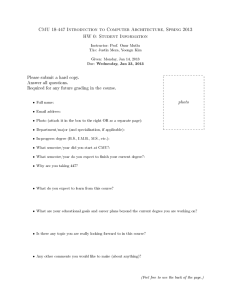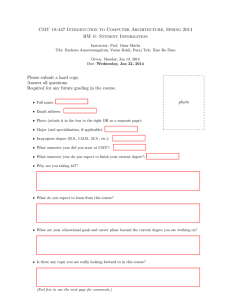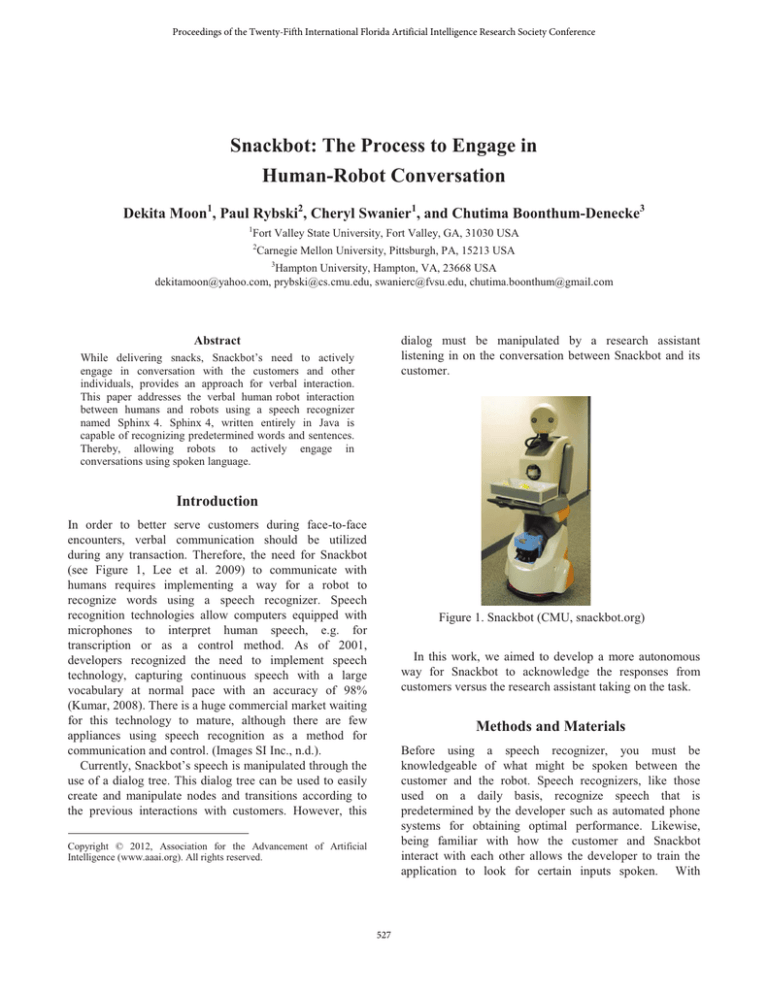
Proceedings of the Twenty-Fifth International Florida Artificial Intelligence Research Society Conference
Snackbot: The Process to Engage in
Human-Robot Conversation
Dekita Moon1, Paul Rybski2, Cheryl Swanier1, and Chutima Boonthum-Denecke3
1
Fort Valley State University, Fort Valley, GA, 31030 USA
2
Carnegie Mellon University, Pittsburgh, PA, 15213 USA
3
Hampton University, Hampton, VA, 23668 USA
dekitamoon@yahoo.com, prybski@cs.cmu.edu, swanierc@fvsu.edu, chutima.boonthum@gmail.com
dialog must be manipulated by a research assistant
listening in on the conversation between Snackbot and its
customer.
Abstract
While delivering snacks, Snackbot’s need to actively
engage in conversation with the customers and other
individuals, provides an approach for verbal interaction.
This paper addresses the verbal human robot interaction
between humans and robots using a speech recognizer
named Sphinx 4. Sphinx 4, written entirely in Java is
capable of recognizing predetermined words and sentences.
Thereby, allowing robots to actively engage in
conversations using spoken language.
Introduction
In order to better serve customers during face-to-face
encounters, verbal communication should be utilized
during any transaction. Therefore, the need for Snackbot
(see Figure 1, Lee et al. 2009) to communicate with
humans requires implementing a way for a robot to
recognize words using a speech recognizer. Speech
recognition technologies allow computers equipped with
microphones to interpret human speech, e.g. for
transcription or as a control method. As of 2001,
developers recognized the need to implement speech
technology, capturing continuous speech with a large
vocabulary at normal pace with an accuracy of 98%
(Kumar, 2008). There is a huge commercial market waiting
for this technology to mature, although there are few
appliances using speech recognition as a method for
communication and control. (Images SI Inc., n.d.).
Currently, Snackbot’s speech is manipulated through the
use of a dialog tree. This dialog tree can be used to easily
create and manipulate nodes and transitions according to
the previous interactions with customers. However, this
Figure 1. Snackbot (CMU, snackbot.org)
In this work, we aimed to develop a more autonomous
way for Snackbot to acknowledge the responses from
customers versus the research assistant taking on the task.
Methods and Materials
Before using a speech recognizer, you must be
knowledgeable of what might be spoken between the
customer and the robot. Speech recognizers, like those
used on a daily basis, recognize speech that is
predetermined by the developer such as automated phone
systems for obtaining optimal performance. Likewise,
being familiar with how the customer and Snackbot
interact with each other allows the developer to train the
application to look for certain inputs spoken. With
Copyright © 2012, Association for the Advancement of Artificial
Intelligence (www.aaai.org). All rights reserved.
527
Snackbot initiating conversation with the customer, it is
fairly easy to recommend what Snackbot will speak.
Snackbot’s dialog legend is a script in which it speaks to
initiate conversation with its customers. The dialog legend
encompasses many subjects that are categorized by the
topic of conversation. The topics used by Snackbot include
greeting, weather, gaining feedback from customers, and
the offering of a snack.
However, Snackbot deals with many customers that are
different. Therefore, customer’s responses may vary
significantly but are very dependent upon the
predetermined dialog of Snackbot. For example, if
Snackbot enters a room and asks for someone by name,
there are several preconceived and data supported
responses that might be made. Snackbot will recognize
these responses and reply. To become familiarized with the
responses that will be received, Snackbot’s customers were
recorded. These recordings were put in writing to be
analyzed and categorized relevant to Snackbot’s dialog
legend. The categorization of the responses made by
customers makes it easier to program Snackbot to look for
certain phrases at specific times and respond accurately.
Once the sentences used by customers were categorized, a
training data set was made.
A training set is a text file listing all possible input
spoken by customers as well as the possibilities that could
have been said. For example, if a one customer states, “I
want a cookie,” it is important to list the potential
alternatives to other snacks used in this sentence e.g. “I
want a banana,” “I want an orange,” etc. Though tedious,
forming the training set is one of the most important steps
in using a speech recognition tool. Figure 2 (Li, 2005)
shows a block diagram of two-stage processing in speech
recognition: feature extraction and classifier (or speech
recognizer). After the training set is made Sphinx-4 tools
can be used to make a language model and plug in the
appropriate data. With these tools, a training set can be
used to create an N-gram. According to Jurafsky and
Martin (2006), an N-gram is a probabilistic model, which
predicts the next word from the previous N-1 words.
clicking compile knowledge base. Once compiled, the tool
will create three documents including an N-gram language
model, sentences, and dictionary to be used. In order to use
these documents, Sphinx-4 should be downloaded from
sourceforge.net. Sphinx-4 also requires JAVA SE 6
Development Kit (JDK), Ant 1.6.0, and Subversion (svn).
Links to this necessary software are provided on the
official website of Sphinx-4. The JDK tool makes your
code able to compile. The Apache Ant is a command-line
tool that is used to drive processes described in build files
as targets and extension points dependent upon each other.
The Subversion tool is recommended but is not required,
allowing you to interact with the svn tree. An Integrated
Drive Electronics (IDE) is also needed to build jar files
used to compile and run Sphinx-4. There are several IDE
tools that can be used but I choose to use Eclipse IDE for
Java Developers.
Sphinx-4 lists several instructions on setting up your
IDE, adding source folders, jar files, and build.xml ant files
from Sphinx-4 to your project. It is important to note,
Sphinx-4 also includes demos that includes its own
language model or grammar, class, Manifest, and xml files.
These files can be manipulated to cater to the needs of your
project. The LiveConnectDemo in particular, provides an
example of how to embed ECMAScript logic into JSGF
grammars that will cause objects in your application to be
activated when a JSGF RuleParse is processed by the
edu.cmu.sphinx.tools.tags.ObjectTagsParser. If the demo is
run and the speaker utters, “I want a pizza with mushroom
and onions,” Sphinx will recognize the order and perform
the action tag designated with the utterance resulting in the
textual feedback of, “pizza with mushroom and onions.”
It is very important to make sure all of the words in the
language model are included in the acoustic model. The
acoustic model is a dictionary used to pronounce words
within the language model using Alphabet symbols. Most
projects will use the cmudict.0.6d file located in the
WSJ 8gau 13dCep 16k 40mel 130Hz 6800Hz.jar.
Figure 3. Two-stage processing in Speech Recognition
Sphinx-4 Tool
The Sphinx Knowledge Base Tool (CMU, n.d.; CMU,
2011) was used to convert the training set into a language
model by simply choosing the training set text file and
Figure 2. Sphinx 4 Live Demo Interface (CMU, 2011)
528
The acoustic model used within Sphinx 4 already provides
a long list of word pronunciation or phonemes that may or
may not include words needed for your individual
purposes.
CMU (2011) provided a live test for Sphinx-4 (see
Figure 3) using a sample test file, shown in Figure 4.
Discussion and Future Work
The ideal method to test the recognition of a language
model is to use the Hello N-Gram or the Live Connect
demo. The Hello N-Gram demo, unlike the Hello World
demo, uses a language mode instead of a grammar file,
offering more flexibility among the grammar used. The
Live Connect demo is an action tag demo that shows how
to use an action tag parser once a speech is recognized. The
Live Connect could be used to plug in code allowing
objects in the application to be activated and can therefore
use a spoken language system to send accurately responses
to be spoken by Snackbot, using the ECMA Script logic.
The results of the Hello Word demo, using the most
common words spoken to Snackbot allowed us to get a feel
of how Sphinx works and what files to manipulate, reaping
desirable results. The accuracy of the test done was
dependent on the pace, the volume, and how clearly words
were spoken. The more enunciated the words were, using a
standard pace of speaking, the more capable the
application was able to recall words. Further research
would allow more changes to be made to the class file,
allowing the voice generator used by the Snackbot, to
respond orally and using more than one tester to assess the
recognition of words.
the left most and closest
the left most purple
the green one right in the middle
it's the uppermost of three in a row
this is a green one
this is the first behind
the one which is the furthest away from you
a purple one on the top right corner
a purple one on the lower right corner
it's a green one
it's in the middle
right after the two green ones in a row
the closest green one
the green one which is in the middle of the
table
the purple one on the left side
the green one on the top right corner
the green one which is in the middle
on the left side there are three purple ones
the lowest of the three purple ones
the next one up
…
Figure 4. Sample N Gram Test File (first 20 lines)
Acknowledgement
This research was supported in part by the National
Science Foundation (CNS-1042466) and various corporate
partners. Any opinions, findings, and conclusions or
recommendations expressed in this material are those of
the authors and do not necessarily reflect the views of the
NSF or our corporate partners.
Results
To obtain preliminary results, changes were made to
Sphinx-4 Hello World demo files 1 for the sake of time. A
short grammar file was successfully used to test a few
frequently used words with Snackbot. These words
include: yes, no, orange, cookie, mystery snack, snickers,
candy, and a few others. Some of the words, such as
snickers, were not already a part of the dictionary.
Therefore, changes were made to the dictionary to include
these words with the proper phoneme using the Hidden
Markov Model. With this grammar, the application was ran
in Eclipse (see Figure 5) and was able to recall sentences
that were spoken, though not at a 100% accuracy. At this
point, though progress was made, Snackbot was not able to
respond orally due to the focus on recognition and less on
incorporating the speech mechanism files and coding.
1
References
CMU. 2011. Sphinx: Open Source Toolkit For Speech
Recognition. http://cmusphinx.sourceforge.net/
CMU.
n.d.
Sphinx
Knowledge
Base
Tool.
http://www.speech.cs.cmu.edu/tools/lmtool.html
Images Scientific Instruments Incorporated. n.d. Build a Speech
Recognition Circuit. Retrieved November 21, 2011, from
http://www.imagesco.com/articles/hm2007/SpeechRecognitionTu
torial01.html
Jurafsky, D., and Martin, J. 2008. Speech and Language
Processing. Upper Saddle River, NJ: Pearson Prentice Hall.
Kumar, R. (2008) Human Computer Interaction. New Delhi,
India: Firewall Media.
Lee, M.K., Forlizzi, J., Rybski, P.E., Crabbe, F., Chung, W.,
Finkle, J., Glaser, E., and Kiesler, S. 2009. The Snackbot:
Documenting the design of a robot for long term human robot
interaction. In Proceedings of HRI 2009, 7 14.
Li, X. 2005. Combination and Generation of Parallel Feature
Streams for Improved Speech Recognition, Ph.D. Thesis, ECE
Department, CMU, February 2005.
http://cmusphinx.sourceforge.net/wiki/tutorialsphinx4
529


